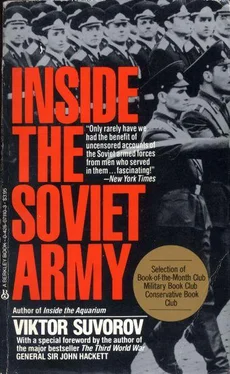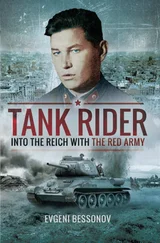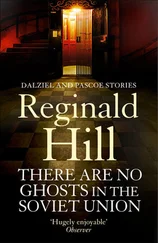Why does the Politburo refuse even the KGB, its favourite offspring, permission to cut the smallest corner off this vast unused field? Because the field is connected to the Kremlin by a direct underground Metro line-Sverdlov Square (under the Kremlin itself)-Mayakovskaya-Byelorusskaya-Dinamo-Aeroport. Muscovites know how often and how quickly this line is closed during any kind of holiday or celebration, or any other event which breaks the normal rhythm of life in the Soviet capital.
Why do the Soviet leaders particularly like this Metro line? Already before the war many spacious underground halls had been built for Moscow Metro stations and the ceremonies to mark the anniversary of the revolution, on 6 November, 1941, were actually held in the Mayakovskiy Metro station. Everyone invited to attend had to reach the station from above, because the line had been closed. Once they were there a special Metro train appeared carrying Stalin, Molotov and Beriya. They came from the Sverdlov Square Metro station. To reach this, they do not, of course, leave the Kremlin. They have their own secret corridor leading to the Metro from right inside its buildings.
Stalin's route out of the Kremlin has existed unchanged for several decades. If necessary, any or all of the members of the Politburo can be taken underground, in complete secrecy and security, to Khodinka, where government aircraft await them in well-guarded hangars. With normal organisation, the Politburo can leave the huge, traffic-laden city within fifteen minutes, during which no outsider will spot official cars speeding along streets in the centre or helicopters flying out of the Kremlin.
North-west of Moscow is another government airfield-Podlipki. (Incidentally, just beside this airfield is the centre at which cosmonauts are trained.) The sub-unit stationed at Podlipki is known as the 1st Task Force of the Civil Air Fleet. In fact it has virtually nothing to do with the Civil Air Fleet-it is a group of government aircraft. Ordinary official flights begin and end at Podlipki. Special official flights, involving ceremonial meetings and escorts, make the brief flight to Sheremetyevo or to one of Moscow's other large airports. In an emergency the Politburo could be evacuated in various ways:
— from the Kremlin in official cars to Podlipki and from there by air to the Supreme Command Post; this is a long and inconvenient route. In addition all Moscow can see what is happening.
— from the Kremlin by Metro to Khodinka and from there by helicopter to Podlipki; this too, is a fairly long route, involving as it does changing from the helicopter to a fixed-wing aircraft.
— the shortest variation-an aircraft of the 1st Task Force of the Civil Air Fleet is either permanently stationed at Khodinka or makes the short flight there from Podlipki, takes the members of the Politburo on board, and vanishes.
3
The special aircraft soars up into the early morning mist over sleeping Moscow. As it gains height it makes a wide turn and sets course for the SCP-the Supreme Command Post, built by Stalin and modernised by his successors. Where is the SCP? How can it be found? Where would Stalin have chosen to site it?
Most probably it is not in Siberia. Today the eastern regions are threatened by China, as they were before the war by Japan. Of course the SCP would not be located in any area which might be threatened, even theoretically, by an aggressor, so it cannot be in the Ukraine, in the Baltic region, in the Caucasus or in the Crimea. Common sense suggests that it must be somewhere as far away as possible from any frontier-in other words in the central part of the RSFSR, which could hardly be over-run by enemy tanks and which could scarcely be reached by enemy bombers, or by aircraft carrying airborne troops. And if hostile aircraft were to reach the spot they could only do so without fighter cover, so they would be defenceless.
Secondly, the SCP cannot, of course, be sited in an open field. There must be a minimum of 200 metres of solid granite above its many kilometres of tunnels and roads. This being so, it can only be in either the Urals or Zhiguli.
Thirdly it stands to reason that it must be surrounded by natural barriers which are so impenetrable that no hunter who happens to enter the area, no geologist who loses his way, no gaol-breaker, no pilot who has survived a crash and wandered for weeks through the taiga can come across the SCP's huge ventilator shafts, descending into terrifying chasms or its gigantic tunnels, their entrances sealed by armoured shields weighing thousands of tons. If Stalin set out to keep the location of the SCP secret he would not have chosen the Urals, whose gentle slopes were being completely worn away by the feet of tens of millions of prisoners. Where could one build a whole town, so that no trace of it would be found by a single living soul? The only possible place is Zhiguli.
Would it be possible to find a better place, anywhere on earth, to build an underground town? Zhiguli is a real natural miracle-a granite monolith 80 kilometres long and 40 wide.
Some geologists maintain that Zhiguli is one single rock, crumbling slightly at the edges but retaining the original, massive unity of all its millions of tons.
It rises out of the boundless steppes, almost entirely encircled by the huge river Volga, which turns it into a peninsula, with rocky shores which stretch for 150 kilometres and fall sheer to the water's edge. Zhiguli is a gigantic fortress built by nature, with granite walls hundreds of metres high, bounded by the waters of the great river. From the air, Zhiguli presents an almost flat surface, overgrown with age-old, impenetrable forest.
The climate is excellent-a cold winter, with hard frosts, but no wind. The summer is dry and hot. This would be the place to build sanatoriums! Here and there in clearings in the virgin forests there are beautiful private houses, fences, barbed wire, Alsatian dogs. One of Stalin's dachas was built here, but nothing was ever written about it, any more than about those at Kuntsevo or Yalta. In the vicinity were the villas of Molotov and Beriya and later of Khrushchev, Brezhnev and others.
Anyone who has travelled on the Moscow Metro will say that there is no better underground system in the world. But I would disagree with this-there is a much better one. In Zhiguli. It was built by the best of the engineers who worked on the Moscow Metro-and by thousands of prisoners.
In Zhiguli tens of kilometres of tunnels have been cut, hundreds of metres deep into the granite monolith and command posts, communications centres, stores and shelters have been built for those who will control the gigantic armies during a war.
In peacetime, no aircraft may fly over this region. Not even the most friendly of foreigners may enter the Zhiguli area, which is protected by a corps of the National Air Defence Forces and by a division of the KGB. Nearby is a huge airfield, at Kurumoch, which is completely empty. This is where the special aircraft will land but it is also intended for use by additional fighter aircraft, to strengthen the defences in the event of war.
Close to Zhiguli is the city of Kuybishev. It, too, is closed to foreigners, and it is useful to remember that this was where the whole Soviet government was based during the last war.
PART FIVE
STRATEGY AND TACTICS
1
For decades, Western military theorists have unanimously asserted that any nuclear war would begin with a first stage during which only conventional weapons would be used. Then, after a certain period, each side would begin, uncertainly and irresolutely at first, to use nuclear weapons of the lowest calibre. Gradually, larger and larger nuclear weapons would be brought into action. These theorists hold varying views on the period which this escalation would take, ranging from a few weeks to several months.
Читать дальше












